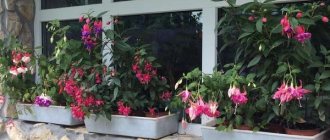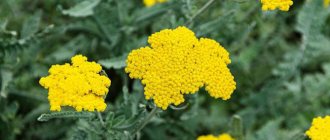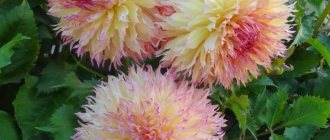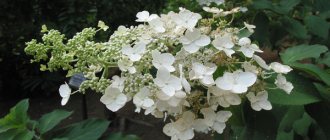Hybrid fuchsia is a popular garden and indoor plant; it does not overwinter in open ground in Russia. In the West, it is often grown as an annual crop; at best, the queen cells are left until spring for propagation. The most versatile is the ampelous fuchsia - it can be planted in a hanging basket, a stationary flowerpot, a flower pot or in a high flowerbed.
Botanical description
Fuchsia is a genus of woody perennials from the fireweed family, which includes about 100 species. Comes from the humid tropics and subtropics of Central and South America, Tahiti, New Zealand.
Appearance
In their homeland, fuchsias are mostly evergreens. In Russia they behave like deciduous perennial trees or shrubs.
The leaves of the crop are collected in whorls of 3-5 pieces or opposite. The length ranges from 1 to 25 cm, but usually within 4-5 cm. The plates are simple, pointed, with a finely toothed edge, elongated oval in shape. The color is green or reddish, there are variegated varieties.
Fuchsia shoots can be relatively flexible and thin, or rigid and erect. The vast majority of cultivars have untrimmed stems that are something in between. Over time, the branches become woody and covered with beige bark.
Bloom
Fuchsia buds form at the tips of the current year's shoots. Flowers consist of two parts, the color of which can be the same, different or differ in shade:
- The calyx is 4 lanceolate, with pointed tips of the lobes, fused at the base into a long tube. After the fuchsia buds have fully bloomed, they are located perpendicular to the petals or slightly cover the base of the corolla, but more often they are bent back to varying degrees. In the latter case, the sepals can be straight, curved, like a bow string, or even slightly twisted. Color: white, all shades of pink or red.
- The fuchsia corolla is often much shorter than the sepals, simple, with 4-5 petals, or terry, looking like a fluffy skirt. The color of the corolla can be white, different shades of pink, red, blue, light blue, violet. Sometimes the petals are painted with contrasting streaks or strokes.
Fuchsias can also be distinguished by their long anthers and pistil protruding beyond the corolla. In ampelous varieties, the buds are attached to a long drooping pedicel and range in size from 1 to 10 cm.
Under natural conditions, the crop is pollinated by hummingbirds. After fertilization, dark purple berries measuring 5-25 mm are set. In most species they are edible and taste like a mixture of citrus and black pepper.
Varieties and varieties
Official sources write that there are more than 2000 fuchsia cultivars. Fans claim that there are from 16 to 22 thousand of them in catalogs. It is impossible to determine the exact quantity without a unified database.
One of the most controversial topics is what variety fuchsia belongs to:
- bush (upright) with rigid, erect shoots;
- semi-ampeloid (lax variety) – first grows upward, droops with age;
- hanging (trailer, pendula) - with thin hanging branches.
There are very few varieties that clearly show the characteristics of the first or third group in any conditions. The majority belongs to the second.
Semi-ampeloid fuchsias can grow strong straight or flexible thin shoots, depending on cultivation and care at home. Whether the bush will be ampelous is influenced by lighting, pruning, and fertilizing.
Experienced gardeners skillfully use this and form plants at their own discretion.
There are ampelous fuchsias with barely enough shoots to cover the container, or with very long stems.
Kirsus Spangles
Circus Spangles is an American large-flowered variety from 1990 with white sepals slightly touched with pink. The skirt is terry, round, the color depends on the growing conditions, it can be raspberry or cherry.
White and red-orange strokes are possible on the petals. The variety is half ampelous.
Bora Bora
Bora Bora - fuchsia of American selection (1966). The sepals are reflexed, white, the corollas are densely double, the skirt is blue, with pale pink large strokes.
Whether the variety will be ampelous depends on its formation.
Marinka
Marinka grows as a bush at a young age. Then the branches begin to bend, the fuchsia turns into an ampelous one.
The flowers are simple, rarely semi-double, the sepals are bright red, the petals are crimson.
Millennium
Millenium is an ampelous variety.
The skirt, depending on the place of planting and care, is very dark burgundy or almost black, the sepals are of a rare purple color.
Blue Angel
Blue Angel is a fuchsia with huge flowers, up to 12 cm.
The sepals are snow-white, the terry skirts are blue. Ampel bush.
Blackie
Fuchsia Blacky is distinguished by crimson sepals bent almost to the peduncle and coal-violet, almost black corollas.
When describing the variety, different sources call it erect or ampelous. The growth pattern depends on how the plant is formed.
Southgate
The name Southgate translates as Southern Gate. Medium-sized soft pink flowers abundantly cover the half-ampeled bush.
The shade of the sepals is slightly darker than that of the terry corollas.
Blue Eaz
Fuchsia Blue Eyes is an ampelous variety with several rows of petals.
The flowers are red-blue, double, large, pink stamens.
Secrets of cultivation
In order for a plant to grow and develop quickly, certain aspects must be taken into account. For example, if the summer is excessively hot, then it is recommended to remove the pot with the crop indoors and place containers with ice around it. To grow flowers, it is best to use ceramic rather than plastic pots. This is explained by the fact that in the summer the root system in them will heat up less.
Like any other plant, fuchsia can be damaged by pests. The most common sighting on a flower is the whitefly. These are miniature flies, white in color. If the plant is shaken, the pest will fly off. The whitefly sucks the sap from the plant, which leads to wilting and drying of the foliage. To combat this pest, it is necessary to use appropriate insecticides. The most frequently used drugs are Aktelik and Aktara. These drugs must be alternated.
If there is increased air or soil humidity, this can lead to powdery mildew. The fight against this disease is carried out with Fundazol or Topaz. A short flowering period of a crop may indicate excessive watering or insufficient fertilizer. In some cases, red spider mites appear on the underside of the crop. When this pest appears, rare pale spots are observed on the foliage, which after a certain time form a single spot. This pest causes yellowing and dying of foliage. Its appearance can be diagnosed against the background of high temperature or dry air. Pest elimination is carried out by Confidor or Agravertin.
Ampelous fuchsia is a very beautiful flower, which can be grown in the garden or on the balcony. In order for a crop to grow fully, it is necessary to provide it with optimal growing conditions. Fuchsia also requires minimal care, which consists of timely watering, pruning, and fertilizing. In order for the crop to bloom fully, it is recommended to provide it with proper wintering. When pests appear, it is necessary to combat them, which will limit the possibility of the flower dying off.
Planting at home
Ampelous fuchsia should be planted 2-3 cuttings in one container:
- Drainage is placed in the pot, the substrate is filled, holes are made according to the shape and size of the root system of young plants.
- Rooted shoots or grown seedlings are taken out of the cups and planted without deepening the central stem.
- Watered.
- If the fuchsia is weak or the root is poorly developed, cover it with a glass cap or cellophane.
- Place in a slightly shaded place.
Strong plants with a powerful root system only need protection from bright sun for 2-3 days and regular spraying of the crown.
Soil requirements
Ampelous fuchsia loves soil with a slightly acidic reaction. It should be structured, loose, and allow water and air to pass through well until the next transplant.
You can use a ready-made substrate for violets or geraniums. Many gardeners who practice intensive care and do not forget about fertilizing grow fuchsias, including hanging ones, in a mixture of peat and coconut fiber. The last component is needed so that in case of accidental drying, you do not place the pot in a bucket of water - peat tends to clump together, dry peat does not absorb liquid well, and coconut fiber absorbs it instantly.
If the owners prefer soil substrates, you can mix equal shares:
- turf soil;
- rotted leaves;
- humus;
- sand;
- sour peat.
Choosing a pot
It is better to grow ampelous fuchsias in ordinary containers. And then put them in a flower pot or hanging basket and take them outside to the balcony.
The container should be proportional to the root, quite close, but containing at least 1 liter of substrate per adult bush. Flowering will begin only when the adventitious shoots entwine the clump.
You can hear the objection that ampelous fuchsia perfectly forms buds in large flowerpots. But not one, but several plants are planted there at once, otherwise it is difficult to obtain a lush, beautiful bush, especially with cascading ampelous varieties.
It is better to take a plastic pot for fuchsia, with several large holes; be sure to place drainage at the bottom. It is needed:
- so that excess moisture does not stagnate in the root area;
- to improve aeration, which is no less important.
The design of a flowerpot or hanging basket is not particularly important. If you care for the ampelous fuchsia correctly, it will cover the walls with flowering vines.
How to care for fuchsia outdoors
Watering
Fuchsia is one of the plants that love moisture. It can either be watered or sprayed. But the main thing here is not to overdo it and show moderation. Fuchsia should be watered every day, but this should be done with a small amount of water. Otherwise, your plant will be at risk of root rot. Before watering, assess the top layer of soil. If the fuchsia is dry at a depth of one centimeter, then watering is very necessary.
Feeding
Fuchsia will develop correctly only if the soil mixture contains a sufficient amount of humus and useful fertilizers
Therefore, it is very important to make sure that you have applied a sufficient amount of phosphorus fertilizers to the ground before planting the plant in open soil. But it doesn't end there
Trimming
Pruning is carried out in late winter - early spring
It is very important to remove the bottom 2/3 of the plant. This includes dead and diseased parts of the fuchsia.
Pruning will significantly rejuvenate the plant and promote abundant flowering in summer and autumn. Trimming rules:
- Twelve hours before pruning, water the plant.
- Remove all bad branches. That is, damaged or dead, thin or intersecting.
- Cut back damaged or weak branches almost all the way to the stem.
- Trim vertical branches.
- Prune healthy branches. The result should be a branch with three buds.
- Remove all old leaves.
Garter
To make the fuchsia bush beautiful, its central part can be tied to small pegs and left to grow further, periodically cutting off the side shoots.
Features of care at home and outdoors
The general rules are mostly the same, although there are differences. Despite the fact that fuchsia comes from the tropics or subtropics, growing the flower in southern gardens is a big problem due to the heat, whiteflies, and overheating of the root system.
Selecting a location
Ampelous fuchsia loves fresh air, but indoors, thanks to air conditioning, it is easier to control the temperature. The plant prefers very moderate temperatures, no more than 20-24° C.
Lighting needs to be intense, bright, but without direct midday rays:
- on the southern window sill protection in the form of a light curtain is required;
- in open ground - planting next to a fence, buildings or larger plants that cover the hanging fuchsia in the middle of the day.
The culture tolerates light partial shade; some cultivars can bloom in poor light, but not in deep shade. In flowerpots, bushes can be placed under a canopy or attached to the branches of a tree with an openwork crown.
Ampelous fuchsias are not planted in flat flower beds - when they come into contact with the ground, the long shoots begin to rot. But they can be placed on tall or terraced flower beds, or in stationary flowerpots.
Watering
Regular irrigation is needed, some sources recommend that the soil be constantly moist, others advise drying it out by a few millimeters. In summer, fuchsia may require daily watering. In flower beds, the soil is mulched with peat or bark to retain moisture; in pots, with sphagnum.
In cool weather and before the dormant period, watering is reduced.
Air humidity needs to be high. In hot weather, the bushes are sprayed several times a day, trying not to get it on the flowers.
Feeding
In the spring, to resume the growing season, grow new shoots and leaves, ampelous fuchsia needs nitrogen; during flowering, phosphorus, potassium plus microelements. The plant especially suffers from magnesium deficiency.
Every 2 weeks in the middle of the season, use complex mineral fertilizers for flowers with the same content of macroelements, for example, 10:10:10 or 20:20:20. Long-acting fertilizers can be used in potted crops.
From the end of summer, nitrogen is eliminated. Feed with phosphorus and potassium preparations.
Formation
Ampelous fuchsia blooms on the tops of the current year's shoots, but only a branched bush will be beautiful. You will have to sacrifice early flowering.
The following algorithm is suitable for young or adult plants, barely rooted cuttings:
- Branches that have grown a little after winter are pinched over 2-3 pairs of leaves.
- The same is done with all the side shoots until the bush takes on a beautiful lush shape.
Depending on the variety and care, 6-12 weeks will pass from the time of the last pinching to the flowering of the ampelous fuchsia.
At the peak of decorativeness, faded corollas and yellowed leaves are removed, and elongated thin shoots are shortened. In case of accidental pollination, which happens extremely rarely, it is better to remove the fruits - nothing worthwhile will grow if you collect the seeds.
At the end of the season, after the leaves of the ampelous fuchsia begin to fly off, the bush needs to be pruned. In hanging varieties, the shoots are shortened by about a third.
Transfer
Transshipment is allowed without disturbing the earthen coma of a flowering plant, although it is better to do this annually in the spring. The operation cannot be performed:
- during the dormant period, when some of the roots die off, life processes are suspended;
- at high temperatures – the crop does not tolerate heat well.
If you are going to plant ampelous fuchsia in open ground, do it after the ground has warmed up to 15° C. The above-ground part of most species and varieties tolerates a short-term decrease to 0° C, holds well at 5° C, but the root does not work, the buds may fall off , even leaves.
Wintering
In potted crops, reduce watering. Bushes are dug out from open ground after the leaves begin to fall, but the thermometer should not cross the zero mark even at night.
The ampelous fuchsias are trimmed by 1/3. Pick off the remaining leaves. Put away for storage.
Wintering on a northern windowsill is only suitable for young plants grown this season from cuttings or seeds. They should remain with the leaves unless they fall off on their own.
The rest of the fuchsias are sent to a frost-free basement, on a glazed balcony. Temperature:
- should not exceed 12° C;
- it is better if it ranges from 6 to 10 ° C;
- permissible minimum – plus 2° C;
- A short-term decrease to 0° C will not cause significant harm.
Providing winter quarters
If the crop is grown in the garden, then it must be provided with proper wintering. At the end of the growing season, it is recommended to cut the flower to half and then dig it up. Plants are placed in ordinary boxes. They should fit snugly against each other. Watering the crop should be done no more than once a week. In order to limit the possibility of plant growth, it is necessary to provide it with a temperature of 10 degrees. After the foliage has completely fallen, the plant must be placed in a dark place. In this case, watering is carried out no more than once a month.
If the room temperature does not reach the required level in winter, then the fuchsia can be additionally covered. In the month of March, it is necessary to carry out appropriate activities that will have a positive effect on the revival of the plant. For this purpose, the flower is pruned so that the length of its shoots does not exceed 15 centimeters. In spring, the plant is replanted. For this purpose, a nutrient soil mixture is used. It is also recommended to increase watering of the plant.
Some gardeners prefer to leave fuchsia in the ground for the winter. To cover the plant in this case it is necessary to use spruce branches. Before frost sets in, the crop is pruned above ground level. After this, it must be covered with earth. The soil layer should be within 20 centimeters. To avoid the negative effects of moisture, it is recommended to place a piece of roofing material or film on top of the embankment. The plant must be opened in early May. The first growth will appear in June. The plant will bloom at the end of summer.
Wintering fuchsia is a fairly important aspect in its cultivation. That is why flower growers are recommended to strictly adhere to its rules.
Reproduction methods
Seed propagation is possible only when purchasing planting material in a store. But with a fairly complex process, the result usually does not correspond to the varietal description or the picture on the pack.
To collect your own seeds, you need to carry out hand pollination, since hummingbirds do not live in Russia. But from the seedlings something unattractive will grow.
Fuchsia does not reproduce by leaves.
To propagate the crop, root the tops of shoots 5-8 cm long with 2-3 pairs of leaves. One node should be in a light substrate or water, the other above the surface. The lower leaves are removed, too large ones are shortened by half.
Germination of cuttings is carried out:
- under film or glass cover;
- at high humidity;
- temperature close to 20° C;
- diffused light is needed.
As the roots grow, the fuchsia is replanted several times a season. Place 2-3 pieces in a permanent wide container so that the ampelous bush is thick and beautiful.











